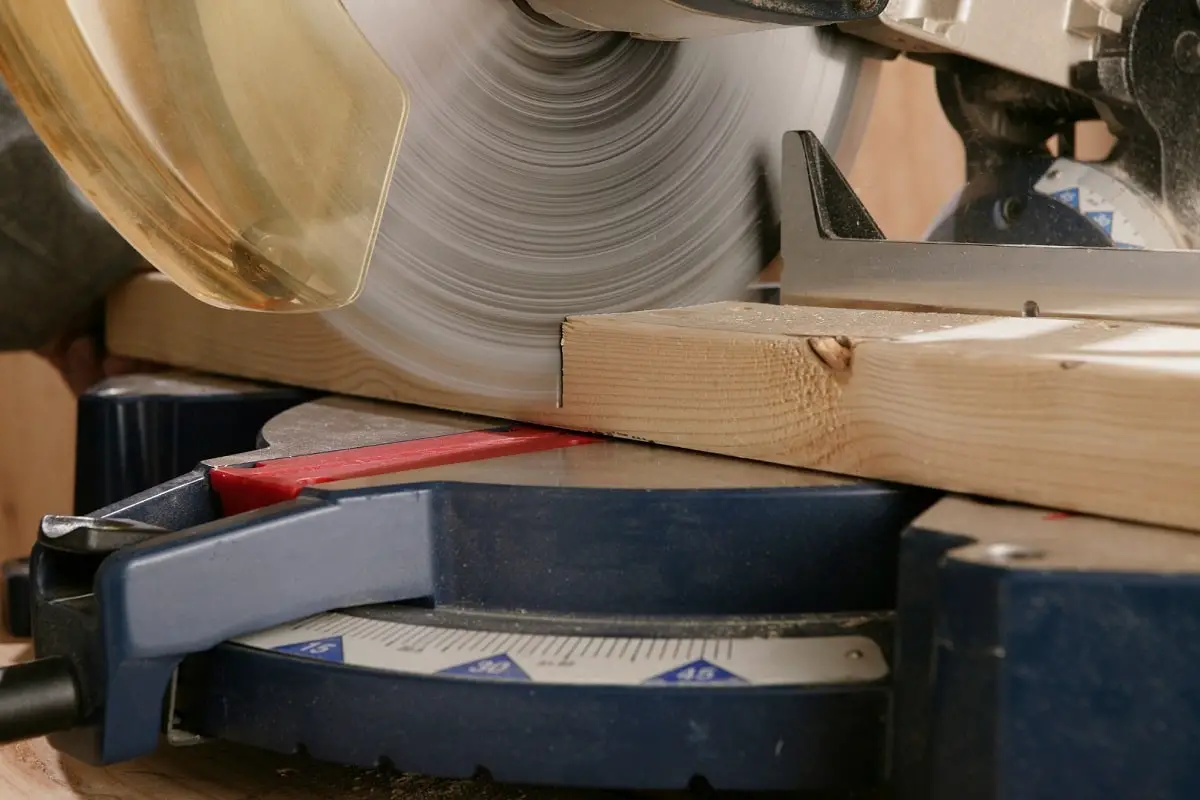Power saws are highly useful and versatile tools that allow you to cut through various materials with complete accuracy and precision. Although they’re known to be quite dangerous and cause many serious injuries, they provide you with more utility and make carpentry and woodworking projects much easier.
Chop saws allow you to cut through various materials easily. Let’s have a look at the materials you can safely and easily cut with them.
Materials You Can Cut With a Chop Saw
- Soft woods: pine, fir, redwood, cedar, balsa, particle board, plywood
- Hard woods: oak, cherry, teak, mahogany, bamboo
- Metals: iron, steel, aluminum, brass, copper
- Flooring: laminate flooring, wood flooring, tiles
- Pipe: iron, galvanized
- Plastic: PVC, polycarbonate, acrylic
- Masonry: tile, brick, concrete, rock
Chop Saw for Metal
When it comes to cutting metal with your chop saw, it all boils down to the type of blade you use to cut various materials. One of the most common applications for a chop saw is to cut non-ferrous metals, such as aluminum, for which you’ll need a more hardened blade, such as a carbide-tipped blade or abrasive disc. These blades help maintain the metal’s smooth finish after cutting it, so there aren’t any rough edges.

Cutting Wood With a Chop Saw
Cutting wood is one of the biggest and most popular applications for chop saws, and for this purpose, you’ll need a blade with anywhere between 40 to 80 teeth. The blade should be made out of carbon steel or high-speed steel.
Cutting Steel With a Chop Saw
Just like wood and metal, you can also use a chop saw to safely cut through steel. However, keep in mind that not all chop saws can be used for this purpose, and you should carefully research the specifications of each one before you make a purchase. A chop saw with the ability to cut through steel will require a special blade, as well as a higher RPM.
Chop Sawing Laminate Flooring
Laminate flooring is considered to be highly durable and tough. Moreover, it can easily break if subjected to too much pressure, so you have to be really careful while using a chop saw to cut through laminate flooring. For this purpose, you need a diamond blade as it can easily cut through the material and also doesn’t get damaged.
Cutting Masonry With a Chop Saw
When it comes to masonry projects that involve cutting bricks or pavers, a chop saw can only be effective if there’s enough room to drive the blade throughout the entire brick. Otherwise, you’re at risk of breaking the brick or getting an uneven cut. To achieve a precise and clean-cut, you’ll need to have a diamond blade, which is hardened and strong enough to cut through hard-to-cut materials like bricks and laminate flooring.
Also, the RPM of your chop saw should be high enough to easily work with the brick or paver, or you can risk burning the motor of your chop saw.
Useful Chop Saws / Miter Saws
DEWALT Chop Saw, Quick-Change, 14-Inch
BOSCH GCM12SD 15 Amp 12 Inch Corded Dual-Bevel Sliding Glide Miter Saw with 60 Tooth Saw Blade
What Should You NOT Cut With a Chop Saw?
Now that we’ve discussed so many things that you can cut with your chop saw, you might also wonder if there are any materials that you shouldn’t try to cut. Naturally, some materials cannot be cut with a chop saw, and you’ll need a different tool.
Any material that’s too big or too wide for the chop saw can’t be cut. Size counts as the throat length of the saw must cover the item you’re cutting or it won’t work.
You generally cannot cut the following materials with a chop saw:
- Rope
- Textiles
- Paper
- Cardboard
- Diamonds
- Glass (shatters)
- Asbestos (releases carcinogenic dust)
- Magnesium (flammable)
- Soft plastics such as vinyl
- Plaster or other powdery materials
Keep in mind that the blade type often determines if you can cut something or not. It’s critical to use the right blade, or you could destroy your saw, the object you’re cutting and potentially your body!
Safety Operating Procedure for Chop Saws
As we mentioned above, all power saws can be dangerous, and they’re the cause of thousands of fatal accidents every year. Therefore, it’s important that you follow a set process that not only keeps you safe but also prolongs and upkeeps the life of your chop saw. Let’s have a look at the safety tips that you can follow:
- Never turn on the chop saw when the blade is in contact with another material or the surface.
- Never turn it on if there’s any debris on the blade of your chop saw.
- Make sure to wear the appropriate safety gear, such as goggles, masks, face shields, work gloves, etc.
- Ensure that your bench or stand is level and not wobbly or unstable, as it can deter your handling of the chop saw.
- When turning on the saw, wait for a few minutes to let it reach maximum RPM.
- There’s a special blade for each material. Make sure not to use the wrong blade for a particular material. Otherwise, you can cause damage to the material, as well as your chop saw.
- Inspect all safety features of your chop saw beforehand to ensure they’re working.
- Turn the saw off when you’re not using it, and unplug it to prevent someone accidentally turning it on.
- Don’t wear loose clothing when operating the chop saw, as it can get caught in the blade.
For more information about chop saws versus other types of saws, see our post Chop Saws Vs. Other Power Saws – A Tool Aficionado’s Comparison Guide
